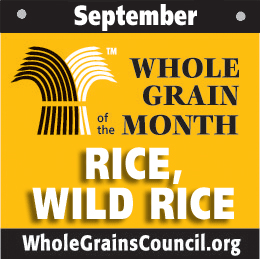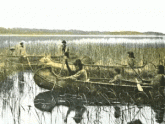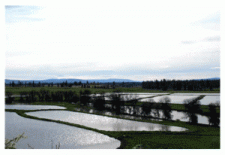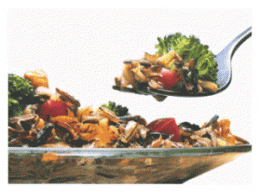Each month we feature a different whole grain on the Whole Grains Council website, including information on its health benefits, cooking tips and recipes, historical/cultural facts, and more. Click here to see the full calendar.
September is not only Whole Grains Month, but also the 20th anniversary of National Rice Month – and the month traditionally celebrated as Wild Rice Month, as well. While these two versatile, nutritious, gluten-free whole grains have similar names, wild rice is not actually a kind of rice, and each grain has a full story of its own. So this month we’re offering two full Grain of the Month features.
Continue reading below for our feature on wild rice.
Click here to access our feature on rice.
All about wild rice
Wild rice [most commonly Zizania aquatica or Zizania palustris] is actually a semi-aquatic grass that historically has grown in lakes, tidal rivers and bays, in water between 2 and 4 feet deep. One of only two commonly-eaten grains native to North America (the other is corn), wild rice originated in the area of the upper Great Lakes in what is now both the U.S. and Canada. Two other varieties of wild rice also exist worldwide: Zizania texana, in the San Marcos River area just north of San Antonio, TX, and Zizania latifolia, a variety found in Asia, prized more for its greens – eaten as a vegetable – than for its grains.
In great swaths of wetlands, wild rice has grown in north-central North America for millenia, germinating in the cold mud under water, then growing throughout the short northern season until its mature heads sway above the surface in the fall. To survive and propagate against the twin threats of migrating birds and early frosts, wild rice evolved to ripen its seeds at different times – a great strategy for avoiding being wiped out, but one that makes traditional-style harvesting a challenge!
As the wild rice ripens, the Anishinaabeg and other people have traditionally harvested it in canoes powered only by long poles, using beater sticks to knock the ripe seeds into the bottom of their canoes. Even today, uncultivated Minnesota wild rice (“wild” wild rice) must by law be harvested in the traditional Native American way, and only by those licensed to do so.
In parallel with this traditional approach, farmers (especially in California, where 70% of the wild rice sold in the U.S. is grown) have commercialized wild rice. But farming doesn’t remove all the challenges! Once wild rice takes root and begins to grow, it develops a weak stem, and leaves that float on the surface of the water. If, at this stage, the water suddenly deepens from floods, the plant’s small roots are easily torn away, and if the water suddenly becomes more shallow, the weak stem is incapable of supporting the plant. So consistent water depth is essential to nurture the growing wild rice plant.
If the plant survives these early stages, it grows in strength and soon its stem becomes strong enough to support the plant even as it grows above the water level. As harvest time approaches, in late August and early September, farmers growing cultivated wild rice begin draining their bogs so that special combines can collect the ripe grains.
Now the wild rice must be processed. Native Americans parched the green seeds in large pots over open fires, then packed them away in birch-bark baskets. Commercial wild rice farmers “cure” the rice until the chlorophyl dissipates, then dry the kernel (still in its hull) using consistent, mechanical methods that impart its signature nutty, smokey flavor. After this, the inedible hull is removed, exposing the black wild rice kernel.
Since wild rice is most commonly associated with the Great Lakes and with California, most people are surprised to learn that it’s found naturally in the majority of U.S. states. Zizania aquatica is found throughout most of Canada and in the Eastern half of the U.S.and Zizania palustris is native to a broad strip of territory through the middle of North America. Wild rice is also now being grown in Hungary.
Because it is difficult to grow, with low yields per acre, wild rice usually costs more than other grains. To bring the cost down, it is often mixed with other grains (white rice and brown rice, especially) rather than eaten on its own. Whether in combination with other grains or by itself, wild rice is a special treat.
Click here to see more photos of wild rice.
Health Benefits of wild rice
Wild rice is slightly higher in protein than most other whole grains, and is a good source of fiber, folate, magnesium, phosphorus, manganese, zinc, Vitamin B6, and niacin. Research on the health benefits of wild rice is scarce, as the grain comprises such a small part of our food supply. The few studies that do exist, however, show tantalizing promise.
Researchers at the University of Minnesota determined in 1994 that wild rice is extremely high in antioxidants. More recently (2009), scientists at the University of Manitoba analyzed eleven different samples of wild rice, and found that the antioxidant activity of wild rice was 30 times greater than that of the white-rice control. Also in 2009, researchers in China (in an animal study) found that wild rice was effective in lowering cholesterol and other lipid measures.
Cooking with Wild Rice
To cook wild rice, combine 1 cup uncooked wild rice with about three cups liquid (such as water or broth) in a 2-3 quart saucepan with a tight-fitting lid. Heat to boiling, then reduce heat, cover and simmer for 35-50 minutes. Wild rice bursts open when it’s cooked, so you can tell at a glance when it’s done. As with all grains, taste a few morsels and keep cooking a few minutes longer if it’s not tender enough for your taste. Fluff with a fork and serve. Yields 3-4 cups.
Storage and freezing. Because it’s extremely low in fat, uncooked wild rice will keep almost indefinitely in a dry, airtight container. Cooked, drained, and tightly-covered wild rice can be stored in the refrigerator for up to a week, and in the freezer for up to six months.
Try some of these recipes featuring wild rice:
Portobello Mushrooms Stuffed with Wild Rice
Chicken and Wild Rice Quesadilla
Wild Rice Salad with Spiced Pepitas and Sun-Dried Cranberries
Wild Rice Salmon Fillo Tartlets
Fun Facts about Wild Rice
Want to win big at Trivial Pursuit next time the subject is wild rice? Here’s what you need to know:
-
When cooked, wild rice expands to three to four times its original size.
- Wild rice is perfect for foodservice: a pound provides up to 15 servings, and wild rice holds well for long periods of time.
-
Wild rice is Minnesota’s official state grain.
-
Traditionally, wild rice is grown in water 2 to 4 feet deep. Cultivated wild rice is grown in less than a foot of water.
-
Commercial production of wild rice in California is a relatively new phenomenon, dating back only to 1977, five years after Yuba City white rice farmer Vince Vanderford first planted Minnesota wild rice seeds on his land.
-
You can pop wild rice, like popcorn. Just heat it in a little oil and shake until it pops.
-
It takes two to three pounds of “green” (unprocessed) wild rice to yield one pound of “finished” wild rice – that is, wild rice that’s ready to be sold for consumption.
-
Of all the natural (uncultivated) lake wild rice grown each year, about ⅛ is grown in the U.S. and the other ⅞ in Canada.
- In 2009, California produced about 10,200,000 pounds of finished wild rice; Minnesota and Canada together produced 10,000,000 pounds; and Hungary produced about 720,000 pounds.
-
Wild rice grows naturally in waterways in almost every state in the U.S. For example, it’s native to the Connecticut River Basin, and the Delaware River and also grows along the Gulf Coast, where it may reach 12 feet high.
Photos and information on this page:
Native Americans harvesting wild rice in 1905: University of Minnesota. California Rice Fields and Wild Rice Broccoli Pilaf: California Wild Rice Advisory Board. Thanks also to Goose Valley Wild Rice and InHarvest for information.




